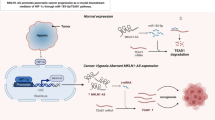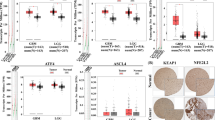Abstract
Introduction
To investigate the effects of lncRNA GAS5 on the proliferation, migration, invasion and apoptosis of brain glioma cells.
Methods
The expression levels of lncRNA GAS5 and GSTM3 in normal glial cells (HEB) and glioma cells (U251 and U87) were detected by RT-qPCR and western blot, respectively. Glioma cells were transfected with ctrl vector, pcDNA-GAS5, siRNA ctrl (siNC) or GSTM3 siRNA and the effects of lncRNA GAS5 and GSTM3 on the proliferation, migration, invasion and apoptosis of glioma cells were detected by CCK-8 assay, transwell assay and Caspase 3/7 activity assay, respectively.
Results
The expression of lncRNA GAS5 was significantly decreased in glioma cell lines U251 and U87 compared with normal glial cells HEB (p < 0.01). In addition, overexpression of lncRNA GAS5 inhibited the proliferation, migration and invasion of U251 and U87 cells, and promoted cell apoptosis as demonstrated by the increased activity of Caspase 3/7. Furthermore, GSTM3 was predicted as a target gene of lncRNA GAS5 by bioinformatics analysis and its expression was increased in glioma cells compared with the normal cells as indicated by western blotting and RT-qPCR experimental results. Silencing of GSTM3 with GSTM3 siRNA decreased the proliferation, migration and invasion but increased the apoptosis of glioma cell lines U251 and U87, which was similar to that the effect lncRNA GAS5 over-expression.
Conclusion
lncRNA GAS5 can effectively inhibit the proliferation, migration and invasion of glioma cells and promote cell apoptosis through targeting GSTM3 expression.





Similar content being viewed by others
Data availability
All data generated or analysed during this study are included in this published article.
Abbreviations
- siNC:
-
siRNA ctrl
- Lnc:
-
Long non-coding
- GAS5:
-
Growth-arrest specific transcript 5
- GSTM3:
-
Glutathione-S-transferase M3
- BCA:
-
Bicinchoninic acid
- NC:
-
Nitrocellulose
- CCRCC:
-
Clear cell renal cell carcinoma
References
Jcl A, Talkenberger K, Seifert M, Klink B, Hawkins-Daarud A, Swanson KR, Hatzikirou H, Deutsch A (2017) The biology and mathematical modelling of glioma invasion: a review. J R Soc Interface 14:20170490
Stupp R, Hegi ME, Mason WP, Bent MJ, Taphoorn MJ, Janzer RC, Ludwin SK, Allgeier A, Fisher B, Belanger K, Hau P (2009) Effects of radiotherapy with concomitant and adjuvant temozolomide versus radiotherapy alone on survival in glioblastoma in a randomised phase III study: 5-year analysis of the EORTC-NCIC trial. Lancet Oncol 10:434–435
Stupp R, Mason WP, van den Bent MJ, Weller M, Fisher B, Taphoorn MJ, Belanger K, Brandes AA, Marosi C, Bogdahn U, Curschmann J, Janzer RC, Ludwin SK, Gorlia T, Allgeier A, Lacombe D, Cairncross JG, Eisenhauer E, Mirimanoff RO (2005) Radiotherapy plus concomitant and adjuvant temozolomide for glioblastoma. N Engl J Med 352:987–996. https://doi.org/10.1056/NEJMoa043330
Wang Z, Guo Q, Wang R, Xu G, Li P, Sun Y, She X, Liu Q, Chen Q, Yu Z, Liu C, Xiong J, Li G, Wu M (2016) The D Domain of LRRC4 anchors ERK1/2 in the cytoplasm and competitively inhibits MEK/ERK activation in glioma cells. J Hematol Oncol 9:130. https://doi.org/10.1186/s13045-016-0355-1
Li B, Huang MZ, Wang XQ, Tao BB, Zhong J, Wang XH, Zhang WC, Li ST (2015) TMEM140 is associated with the prognosis of glioma by promoting cell viability and invasion. J Hematol Oncol 8:89. https://doi.org/10.1186/s13045-015-0187-4
Xiao C, Wu CH, Hu HZ (2016) LncRNA UCA1 promotes epithelial-mesenchymal transition (EMT) of breast cancer cells via enhancing Wnt/beta-catenin signaling pathway. Eur Rev Med Pharmacol Sci 20:2819
Zhou M, Hou Y, Yang G, Zhang H, Tu G, Du YE, Wen S, Xu L, Tang X, Tang S (2016) LncRNA-Hh strengthen cancer stem cells generation in twist-positive breast cancer via activation of hedgehog signaling pathway. Stem Cells 34:55–66
Han P, Li J, Zhang B, Lv J, Li Y, Gu X, Yu Z, Jia Y, Bai X, Li L (2017) The lncRNA CRNDE promotes colorectal cancer cell proliferation and chemoresistance via miR-181a-5p-mediated regulation of Wnt/β-catenin signaling. Mol Cancer 16:9
Peng WX, Koirala P, Mo YY (2017) LncRNA-mediated regulation of cell signaling in cancer. Oncogene 36:5661
Kanduri C (2016) Long noncoding RNAs: Lessons from genomic imprinting. Biochim Biophys Acta 1859:102–111
Gong C, Popp MW, Maquat LE (2012) Biochemical analysis of long non-coding RNA-containing ribonucleoprotein complexes. Methods 58:88–93
Fatica A, Bozzoni I (2014) Long non-coding RNAs: new players in cell differentiation and development. Nat Rev Genet 15:7–21
Vassallo I, Zinn P, Lai M, Rajakannu P, Hamou MF, Hegi ME (2016) WIF1 re-expression in glioblastoma inhibits migration through attenuation of non-canonical WNT signaling by downregulating the lncRNA MALAT1. Oncogene 35:12–21
Cui Y, Zhang F, Zhu C, Geng L, Tian T, Liu H (2017) Upregulated lncRNA SNHG1 contributes to progression of non-small cell lung cancer through inhibition of miR-101-3p and activation of Wnt/β-catenin signaling pathway. Oncotarget 8:17785–17794
Sun M, Kraus WL (2015) From Discovery to Function: The Expanding Roles of Long Non-Coding RNAs in Physiology and Disease. Endocr Rev 36:25–64
Wang TH, Chan CW, Fang JY, Shih YM, Liu YW, Wang TCV, Chen CY (2017) 2-O-Methylmagnolol upregulates the long non-coding RNA, GAS5, and enhances apoptosis in skin cancer cells. Cell Death Dis 8:e2638
Li W, Zhai L, Wang H, Liu C, Zhang J, Chen W, Wei Q (2016) Downregulation of LncRNA GAS5 causes trastuzumab resistance in breast cancer. Oncotarget 7:27778–27786
Wang M, Guo C, Wang L, Luo G, Huang C, Li Y, Liu D, Zeng F, Jiang G, Xiao X (2018) Long noncoding RNA GAS5 promotes bladder cancer cells apoptosis through inhibiting EZH2 transcription. Cell Death Dis 9:238
Renganathan A, Kresoja-Rakic J, Echeverry N, Ziltener G, Vrugt B, Opitz I, Stahel RA, Felley-Bosco E (2014) GAS5 long non-coding RNA in malignant pleural mesothelioma. Mol Cancer 13(1):119
Guo C, W-q Song, Sun P, Jin L, H-y Dai (2015) LncRNA-GAS5 induces PTEN expression through inhibiting miR-103 in endometrial cancer cells. J Biomed Sci 22:100
Wen Q, Liu Y, Lyu H, Xu X, Wu Q, Liu N, Yin Q, Li J, Sheng X (2017) Long noncoding RNA GAS5, which acts as a tumor suppressor via microRNA 21, regulates cisplatin resistance expression in cervical cancer. Int J Gynecol Cancer 27:1096
Pectasides D, Kamposioras K, Papaxoinis G, Pectasides E (2008) Chemotherapy for recurrent cervical cancer. Cancer Treat Rev 34:603–613
Huang J, Tan PH, Thiyagarajan J, Bay BH (2003) Prognostic significance of glutathione S-transferase-pi in invasive breast cancer. Mod Pathol 16:558
Dixon DP, Edwards R (2010) Glutathione Transferases. Annu Rev Pharmacol Toxicol 8:e0131
Meding S, Balluff B, Elsner M, Schöne C, Rauser S, Nitsche U, Maak M, Schäfer A, Hauck SM, Ueffing M (2012) Tissue-based proteomics reveals FXYD3, S100A11 and GSTM3 as novel markers for regional lymph node metastasis in colon cancer. J Pathol 228:459–470
Mitra AP, Pagliarulo V, Yang D, Waldman FM, Datar RH, Skinner DG, Groshen S, Cote RJ (2009) Generation of a concise gene panel for outcome prediction in urinary bladder cancer. J Clin Oncol 27:3929–3937
Ye Z, Song H, Higgins JPT, Pharoah P, Danesh J (2006) Five glutathione S-transferase gene variants in 23,452 cases of lung cancer and 30,397 controls: meta-analysis of 130 studies. Plos Med 3:e91
Medeiros R, Vasconcelos A, Costa S, Pinto D, Ferreira P, Lobo F, Morais A, Oliveira J, Lopes C (2004) Metabolic susceptibility genes and prostate cancer risk in a southern European population: the role of glutathione S-transferases GSTM1, GSTM3, and GSTT1 genetic polymorphisms. Prostate 58:414–420
Checarojas A, Delgadillosilva LF, Velascoherrera M, Andradedomínguez A, Gil J, Santillán O, Lozano L, Toledoleyva A, Ramíreztorres A, Talamasrohana P (2018) GSTM3 and GSTP1: novel players driving tumor progression in cervical cancer. Oncotarget 9:21696–21714
Louie SM, Grossman EA, Crawford LA, Ding L, Camarda R, Huffman TR, Miyamoto DK, Goga A, Weerapana E, Nomura DK (2016) GSTP1 is a driver of triple-negative breast cancer cell metabolism and pathogenicity. Cell Chem Biol 23:567–578
Xu Y, Wang J, Dong W (2014) GSTM3 A/B polymorphism and risk for head and neck cancer: a meta-analysis. PLoS ONE 9:e83851
Kumar B, Hovland AR, Prasad JE, Clarkson E, Cole WC, Nahreini P, Freed CR, Prasad KN (2001) Establishment of human embryonic brain cell lines. Vitro Cell Dev Biol Animal 37:259–262
Nahreini P, Andreatta C, Kumar B, Hanson A, Edwards-Prasad J, Freed CR, Prasad KN (2003) Distinct patterns of gene expression induced by viral oncogenes in human embryonic brain cells. Cell Mol Neurobiol 23:27–42
Sith S, Reardon DA, Annick D, Quinn JA, Vredenburgh JJ, Rich JN (2010) Molecularly targeted therapy for malignant glioma. Cancer 110:13–24
Liu Y, Zhao J, Zhang W, Gan J, Hu C, Huang G, Zhang Y (2015) lncRNA GAS5 enhances G1 cell cycle arrest via binding to YBX1 to regulate p21 expression in stomach cancer. Sci Rep 5:10159
Liang W, Lv T, Shi X, Liu H, Zhu Q, Zeng J, Yang W, Yin J, Song Y (2016) Circulating long noncoding RNA GAS5 is a novel biomarker for the diagnosis of nonsmall cell lung cancer. Medicine 95:e4608
Huo JF, Chen XB (2018) Long noncoding RNA growth arrest-specific 5 facilitates glioma cell sensitivity to cisplatin by suppressing excessive autophagy in an mTOR-dependent manner. J Cell Biochem 120:6127–6136
Liu Q, Yu W, Zhu S, Cheng K, Xu H, Lv Y, Long X, Ma L, Huang J, Sun S (2019) Long noncoding RNA GAS5 regulates the proliferation, migration, and invasion of glioma cells by negatively regulating miR-18a-5p. J Cell Physiol 234:757–768
Zhao X, Liu Y, Zheng J, Liu X, Chen J, Liu L, Wang P, Xue Y (2017) GAS5 suppresses malignancy of human glioma stem cells via a miR-196a-5p/FOXO1 feedback loop. Biochem Biophys Acta 1864:1605–1617
Checa-Rojas A, Delgadillo-Silva LF, del Castillo Velasco-Herrera M, Andrade-Domínguez A, Gil J, Santillán O, Lozano L, Toledo-Leyva A, Ramírez-Torres A, Talamas-Rohana P (2018) GSTM3 and GSTP1: novel players driving tumor progression in cervical cancer. Oncotarget 9:21696–21714
Wang Y, Yang ZY, Chen YH, Li F, Shen H, Yu Y, Huang HY, Shen ZY (2018) A novel functional polymorphism of GSTM3 reduces clear cell renal cell carcinoma risk through enhancing its expression by interfering miR-556 binding. J Cell Mol Med 22:3005–3015
Zhang Y, Hughes KS (2009) Genetic variations in xenobiotic metabolic pathway genes, personal hair dye use, and risk of non-Hodgkin lymphoma. Am J Epidemiol 170:1222–1230
Gabriel E, Yong-Shu Z, Qing-Lin L, Ji-Xiang X, Yuan Y, Qun Z (2014) Long non-coding RNAs in stem cells and cancer. World J Clin Oncol 5:134–141
Man-Tang Q, Jing-Wen H, Rong Y, Lin X (2013) Long noncoding RNA: an emerging paradigm of cancer research. Tumour Biol J Int Soc Oncodev Biol Med 34:613–620
Yang W, Hong L, Xu X, Wang Q, Huang J, Jiang L (2017) LncRNA GAS5 suppresses the tumorigenesis of cervical cancer by downregulating miR-196a and miR-205. Tumour Biol 39:1010428317711315
Guo C, Song WQ, Sun P, Jin L, Dai HY (2015) LncRNA-GAS5 induces PTEN expression through inhibiting miR-103 in endometrial cancer cells. J Biomed Sci 22:100
Geng X, Xu X, Zhao Y, Hu J, Xu J, Jia P, Ding X, Teng J (2018) The effect of long noncoding RNA GAS5 on apoptosis in renal ischemia/reperfusion injury. Nephrology 24:405–413
Zhao X, Wang P, Liu J, Zheng J, Liu Y, Chen J, Xue Y (2015) Gas5 exerts tumor-suppressive functions in human glioma cells by targeting miR-222. Mol Ther 23:1899–1911
Acknowledgements
This study was supported by the Innovation of Science and Technology Committee of Shenzhen City (Grant Number: JCYJ20150402155418386) and the Projects of Public Welfare Research and Capacity Development of Guangdong Province, China (Grant Number: 2014A020212171).
Author information
Authors and Affiliations
Corresponding authors
Ethics declarations
Conflict of interest
The authors declare that they have no conflict of interest.
Ethical approval
This article does not contain any studies with human participants or animals performed by any of the authors.
Additional information
Publisher's Note
Springer Nature remains neutral with regard to jurisdictional claims in published maps and institutional affiliations.
Rights and permissions
About this article
Cite this article
Li, G., Cai, Y., Wang, C. et al. LncRNA GAS5 regulates the proliferation, migration, invasion and apoptosis of brain glioma cells through targeting GSTM3 expression. The effect of LncRNA GAS5 on glioma cells. J Neurooncol 143, 525–536 (2019). https://doi.org/10.1007/s11060-019-03185-0
Received:
Accepted:
Published:
Issue Date:
DOI: https://doi.org/10.1007/s11060-019-03185-0




